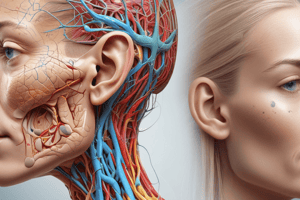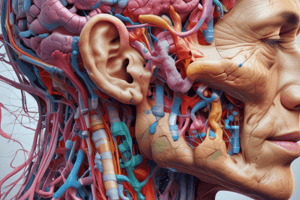Podcast
Questions and Answers
What characterizes complete flaccid facial paralysis?
What characterizes complete flaccid facial paralysis?
- Partial loss of facial motion with some asymmetry
- Total loss of dynamic facial motion with asymmetry at rest (correct)
- Presence of mild synkinesis on the affected side
- Full preservation of facial movement and symmetry
Which of the following best describes irreversible paralysis?
Which of the following best describes irreversible paralysis?
- Total atrophy of muscle fibers with neurological barriers to recovery (correct)
- Partial nerve damage with potential for regeneration
- Temporary conduction block due to pressure on the nerve
- Motor dysfunction with viable motor units
What is the primary factor that determines the ultimate nature of facial paralysis?
What is the primary factor that determines the ultimate nature of facial paralysis?
- The presence of collateral nerve pathways
- The type of facial movements present prior to injury
- The degree of injury to the facial nerve (correct)
- The patient's age and overall health status
Which classification of nerve injury indicates a complete nerve transection?
Which classification of nerve injury indicates a complete nerve transection?
Which type of paralysis involves compensatory hyperactivity on the unaffected side?
Which type of paralysis involves compensatory hyperactivity on the unaffected side?
What is the prognosis for recovery in a case of second-degree injury?
What is the prognosis for recovery in a case of second-degree injury?
Which of the following statements regarding Sunderland classification is true?
Which of the following statements regarding Sunderland classification is true?
What condition is characterized by nasal obstruction and oral incompetence?
What condition is characterized by nasal obstruction and oral incompetence?
What is the main characteristic of first-degree nerve injury, also known as neuropraxia?
What is the main characteristic of first-degree nerve injury, also known as neuropraxia?
Flashcards
Complete Flaccid Facial Paralysis
Complete Flaccid Facial Paralysis
Complete paralysis of facial muscles with no movement, causing asymmetry, droopy eyelid, difficulty breathing through the nose, and trouble eating.
Non-flaccid Facial Paralysis
Non-flaccid Facial Paralysis
Partial facial paralysis with some movement, often with involuntary contractions (synkinesis) and overactivity on the unaffected side.
Reversible Facial Paralysis
Reversible Facial Paralysis
Facial paralysis where the nerve's function is disrupted but the nerve fibers are intact. Recovery is expected without surgery.
Irreversible Facial Paralysis
Irreversible Facial Paralysis
Signup and view all the flashcards
Sunderland Classification
Sunderland Classification
Signup and view all the flashcards
Neuropraxia (Sunderland Grade 1)
Neuropraxia (Sunderland Grade 1)
Signup and view all the flashcards
Axonotmesis (Sunderland Grade 2)
Axonotmesis (Sunderland Grade 2)
Signup and view all the flashcards
Neurotmesis (Sunderland Grade 3)
Neurotmesis (Sunderland Grade 3)
Signup and view all the flashcards
Sunderland Grade 4
Sunderland Grade 4
Signup and view all the flashcards
Sunderland Grade 5
Sunderland Grade 5
Signup and view all the flashcards
Study Notes
Facial Paralysis Types and Treatment
- Identifying the specific type of facial paralysis is crucial for appropriate treatment.
- Complete flaccid paralysis results in facial asymmetry at rest, complete lack of facial movement, lagophthalmos (inability to close the eye), nasal obstruction, and oral incompetence.
- Nonflaccid paralysis shows varying degrees of facial movement, often with synkinesis (involuntary muscle contractions) on the affected side and compensatory muscle activity on the unaffected side.
- Reversible paralysis involves motor dysfunction with intact motor units (motor neuron, muscle fiber, and axon terminals). The movement architecture is intact and viable.
- Irreversible paralysis is characterized by neuromuscular discontinuity, resulting in muscle fiber atrophy, fibrosis, deteriorated nerve sheaths, and loss of supportive cells. Reinnervation is hindered in this case.
Facial Nerve Injury and Classification
- The severity of facial nerve injury determines the type and extent of paralysis.
- The Sunderland classification categorizes nerve injuries based on axonal damage.
- First-degree injury (neuropraxia): Results from nerve compression or ischemia. No significant axon damage, spontaneous complete recovery is expected.
- Second-degree injury (axonotmesis): Involves axonal injury, but the endoneurium (protective sheath around axons) remains intact. Wallerian degeneration occurs (dying back of axon distal to the injury), but regeneration through the endoneurium allows complete recovery.
- Third-degree injury (neurotmesis): Causes endoneurial damage. Regeneration is disorganized, with excessive axonal branching. Recovery is prolonged and often incomplete, with synkinesis (involuntary movements) sometimes present.
- Fourth-degree injury: Involves multiple fascicles (bundles of axons). Severe injury.
- Fifth-degree injury: Complete nerve transection. Recovery without surgical intervention is not possible. Complete function cannot be restored.
Studying That Suits You
Use AI to generate personalized quizzes and flashcards to suit your learning preferences.


